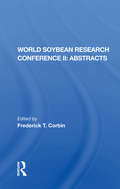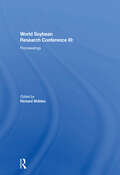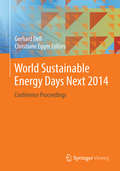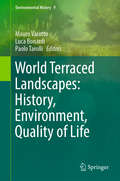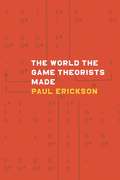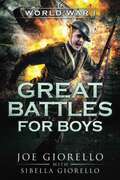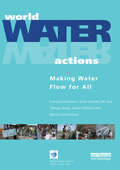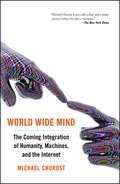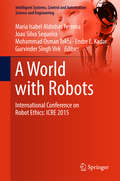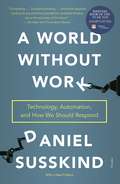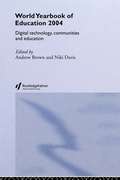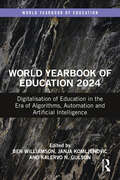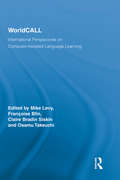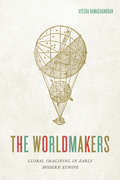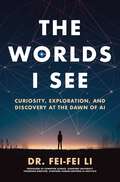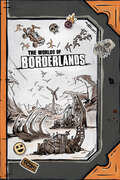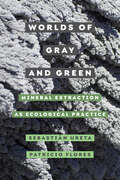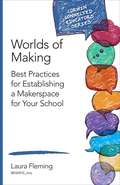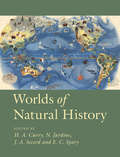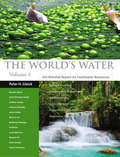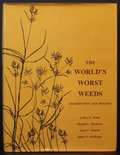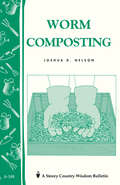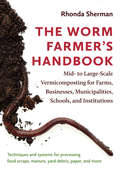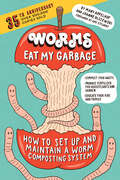- Table View
- List View
World Soybean Research Conference Ii, Abstracts
by Frederick T CorbinThe result of strong international interest in the soybean, the World Soybean Research Conference II was held March 26-29, 1979, at North Carolina State University. This volume contains summaries of the more than two hundred papers presented at that meeting. The authors, international authorities in their fields, represent sixteen areas of professi
World Soybean Research Conference III: Proceedings
by Richard ShiblesThis volume consists of full length manuscripts of 159 of the 165 invited papers presented at World Soybean Research Conference III that was held in the Scheman Continuing Education Building at Iowa State University August 12-17, 1984. The authors, widely recognized as world authorities in their fields, represent all aspects of soybean research activity: breeding and genetics, crop and soil management, economics, entomology, food science, international programs, nematology, pathology, physiology, plant nutrition, rhizobiology, utilization, and weed science. This proceedings, which contains more than 1200 pages of information including many tables and figures, represents the most extensive compilation of soybean research results since the previous proceedings were published in 1980. It should be of value to research scientists, students and administrators alike.
World Sustainable Energy Days Next 2014
by Gerhard Dell Christiane EggerThese conference proceedings contain contributions to one of Europe's largest annual conferences on energy efficiency and renewable energy. From two main fields - biomass and energy efficiency in buildings - contributions offer an insight into the research work and the scientific findings and developments of young researchers from all over the world. The papers were selected by a high-level scientific committee for oral presentation. They also communicate results, trends and opinions that will concern and influence the world's energy experts and policy makers over the next decades. The conference was held from 26-27 February 2014.
World Terraced Landscapes: History, Environment, Quality of Life (Environmental History #9)
by Mauro Varotto Luca Bonardi Paolo TarolliThis volume collects the best scientific contribution presented in the 3rd World Conference on Terraced Landscapes held in Italy from 6th to 15th October 2016, offering a deep and multifaceted insight into the remarkable heritage of terraced landscapes in Italy, in Europe and in the World (America, Asia, Australia). It consists of 2 parts: a geographical overview on some of the most important terraced systems in the world (1st part), and a multidisciplinary approach that aims to promote a multifunctional vision of terraces, underlining how these landscapes meet different needs: cultural and historical values, environmental and hydrogeological functions, quality and variety of food, community empowerment and sustainable development (2nd part). The volume offers a great overview on strengths, weaknesses, functions and strategies for terraced landscapes all over the world, summarizing in a final manifest the guidelines to provide a future for these landscapes as natural and cultural heritage.
The World the Game Theorists Made
by Paul EriksonIn recent decades game theory--the mathematics of rational decision-making by interacting individuals--has assumed a central place in our understanding of capitalist markets, the evolution of social behavior in animals, and even the ethics of altruism and fairness in human beings. With game theory's ubiquity, however, has come a great deal of misunderstanding. Critics of the contemporary social sciences view it as part of an unwelcome trend toward the marginalization of historicist and interpretive styles of inquiry, and many accuse its proponents of presenting a thin and empirically dubious view of human choice. The World the Game Theorists Made seeks to explain the ascendency of game theory, focusing on the poorly understood period between the publication of John von Neumann and Oscar Morgenstern's seminal Theory of Games and Economic Behavior in 1944 and the theory's revival in economics in the 1980s. Drawing on a diverse collection of institutional archives, personal correspondence and papers, and interviews, Paul Erickson shows how game theory offered social scientists, biologists, military strategists, and others a common, flexible language that could facilitate wide-ranging thought and debate on some of the most critical issues of the day.
World War I (Great Battles for Boys)
by Joe Giorello Sibella GiorelloYoung readers experience an unforgettable journey into World War I. They learn about the major battles, leaders, tactics, and strategies that helped the Allies topple the Axis powers. They'll also learn about new inventions, such as airplanes and tanks, which proved crucial to “The Great War." <p><p> Among the battles covered: <p> • Battle of Tannenberg: outnumbered German soldiers plan a sneak attack that destroys Russian forces, capturing 150,000 prisoners of war. <p>• Battle of the Somme: One of military history’s worst follies, this battle ended with more than one million casualties—and yet achieved almost nothing for either side. <p>• Battle of Cantigny: A little-known battle that proved the late-arriving American forces reached the Western Front ready to win. <p><p> Other chapters cover WWI’s most fascinating figures, such as Lawrence of Arabia, Sergeant York, the Harlem Hellfighters, and world events, including the Russian Revolution of 1917.
World Water Actions: Making Water Flow for All
by Francois GuerquinThis text is divided into three parts. Part I focuses on the need for management to assess the challenges of water scarcity and plan changes based on proper valuation and financial instruments, international co-operation and efficient use. Part II analyses the problems of water scarcity and the available solutions in each main sector: water supply and sanitation, energy, health, agriculture, ecosystems and biodiversity. Part III assesses the state of the debate following the third World Water Forum and sets out the priorities for action, including increased investment, institutional reform and capacity building in the water sector. Downloadable resources with extensive case studies and statistical data accompanies this text.
World Wide Mind: The Coming Integration of Humans and Machines
by Michael ChorostWhat if digital communication felt as real as being touched? This question led Michael Chorost to explore profound new ideas triggered by lab research around the world, and the result is the book you now hold. Marvelous and momentous, World Wide Mind takes mind-to-mind communication out of the realm of science fiction and reveals how we are on the verge of a radical new understanding of human interaction. Chorost himself has computers in his head that enable him to hear: two cochlear implants. Drawing on that experience, he proposes that our Paleolithic bodies and our Pentium chips could be physically merged, and he explores the technologies that could do it. He visits engineers building wearable computers that allow people to be online every waking moment, and scientists working on implanted chips that would let paralysis victims communicate. Entirely new neural interfaces are being developed that let computers read and alter neural activity in unprecedented detail. But we all know how addictive the Internet is. Chorost explains the addiction: he details the biochemistry of what makes you hunger to touch your iPhone and check your email. He proposes how we could design a mind-to-mind technology that would let us reconnect with our bodies and enhance our relationships. With such technologies, we could achieve a collective consciousness--a World Wide Mind. And it would be humankind's next evolutionary step. With daring and sensitivity, Chorost writes about how he learned how to enhance his own relationships by attending workshops teaching the power of touch. He learned how to bring technology and communication together to find true love, and his story shows how we can master technology to make ourselves more human rather than less. World Wide Mind offers a new understanding of how we communicate, what we need to connect fully with one another, and how our addiction to email and texting can be countered with technologies that put us--literally--in each other's minds.
A World with Robots: International Conference on Robot Ethics: ICRE 2015 (Intelligent Systems, Control and Automation: Science and Engineering #84)
by Maria Isabel Aldinhas Ferreira Joao Silva Sequeira Mohammad Osman Tokhi Endre E. Kadar Gurvinder Singh VirkThis book contains the Proceedings of the International Conference on Robot Ethics, held in Lisbon on October 23 and 24, 2015. The conference provided a multidisciplinary forum for discussing central and evolving issues concerning safety and ethics that have arisen in various contexts where robotic technologies are being applied. The papers are intended to promote the formulation of more precise safety standards and ethical frameworks for the rapidly changing field of robotic applications. The conference was held at Pavilh#65533;o do Conhecimento/Ci#65533;ncia Viva in Lisbon and brought together leading researchers and industry representatives, promoting a dialogue that combines different perspectives and experiences to arrive at viable solutions for ethical problems in the context of robotics. The conference topics included but were not limited to emerging ethical, safety, legal and societal problems in the following domains: * Service/Social Robots: Robots performing tasks in human environments and involving close human-robot interactions in everyday households; robots for education and entertainment; and robots employed in elderly and other care applications * Mobile Robots: Self-driving vehicles, autonomous aircraft, trains, cars and drones * Robots used in medicine and for therapeutic purposes * Robots used in surveillance and military functions
A World Without Work: Technology, Automation, and How We Should Respond
by Daniel SusskindA New York Times Book Review Editors’ ChoiceFrom an Oxford economist, a visionary account of how technology will transform the world of work, and what we should do about itFrom mechanical looms to the combustion engine to the first computers, new technologies have always provoked panic about workers being replaced by machines. For centuries, such fears have been misplaced, and many economists maintain that they remain so today. But as Daniel Susskind demonstrates, this time really is different. Breakthroughs in artificial intelligence mean that all kinds of jobs are increasingly at risk.Drawing on almost a decade of research in the field, Susskind argues that machines no longer need to think like us in order to outperform us, as was once widely believed. As a result, more and more tasks that used to be far beyond the capability of computers – from diagnosing illnesses to drafting legal contracts, from writing news reports to composing music – are coming within their reach. The threat of technological unemployment is now real.This is not necessarily a bad thing, Susskind emphasizes. Technological progress could bring about unprecedented prosperity, solving one of humanity’s oldest problems: how to make sure that everyone has enough to live on. The challenges will be to distribute this prosperity fairly, to constrain the burgeoning power of Big Tech, and to provide meaning in a world where work is no longer the center of our lives. Perceptive, pragmatic, and ultimately hopeful, A World Without Work shows the way.
World Yearbook of Education 2004: Digital Technologies, Communities and Education (World Yearbook of Education)
by Andrew Brown Niki DavisA real revolution is taking place in the way in which we conceptualise and practise education and learning. This book sets out to explore the immense impact which digital technology is having on education around the world and the ways in which it is used by a wide range of individuals and communities.Contributors analyse changes in technology such as e-mail, the Internet, digital video and other media, but also the effect of this new technology on the way people live and learn around the world.Cultural changes taking place range from the blurring of boundaries between formal and informal learning to the development of new 'virtual communities' which revolve around particular social or cultural interests, and which serve as a crucial tool and source of identity for spatially displaced communities such as refugees.Digital technology is changing the way we all live, and this book is an authoritative study of these changes in all their diversity.
World Yearbook of Education 2024: Digitalisation of Education in the Era of Algorithms, Automation and Artificial Intelligence (World Yearbook of Education)
by Ben Williamson Janja Komljenovic Kalervo N. GulsonProviding a comprehensive, global overview of the digitalisation of education, the World Yearbook of Education 2024 examines the ways advanced digital technologies are transforming educational practices, institutions and policy processes.Establishing a critical research agenda for analysing the digitalisation of education, the carefully selected chapters in this collection interrogate the current impacts of new digital technologies, emerging controversies over emerging data practices and future implications of algorithmic systems, automated decision-making and AI in education. Organised into four sections, the contributions in the collection examine the following: The historical, scientific and technical foundations of contemporary digitalisation in education The political and economic dynamics that underpin the education technology industry and new platform models of education How algorithms, automation and AI support new modes of data-driven governance and control of education systems Controversies over the inequitable effects of digitalisation in education, and proposals for data justice, ethics and regulation This resource is ideal reading for researchers, students, educational practitioners and policy officials interested in understanding the future of digital technologies in education.
WorldCALL: International Perspectives on Computer-Assisted Language Learning (Routledge Studies in Computer Assisted Language Learning)
by Mike Levy Françoisee Blin Claire Bradin Siskin Osamu TakeuchiAs technological innovation continues to affect language pedagogy, there is an increasing demand for information, exemplars, analysis and guidance. This edited volume focuses on international perspectives in Computer-Assisted Language Learning (CALL) in all of its forms, including Technology Enhanced Language Learning, Network-Based Language Learning, Information and Communication Technologies for Language Learning.
The Worldmakers: Global Imagining in Early Modern Europe
by Ayesha RamachandranIn this beautifully conceived book, Ayesha Ramachandran reconstructs the imaginative struggles of early modern artists, philosophers, and writers to make sense of something that we take for granted: the world, imagined as a whole. Once a new, exciting, and frightening concept, “the world” was transformed in the sixteenth and seventeenth centuries. But how could one envision something that no one had ever seen in its totality? The Worldmakers moves beyond histories of globalization to explore how “the world” itself—variously understood as an object of inquiry, a comprehensive category, and a system of order—was self-consciously shaped by human agents. Gathering an international cast of characters, from Dutch cartographers and French philosophers to Portuguese and English poets, Ramachandran describes a history of firsts: the first world atlas, the first global epic, the first modern attempt to develop a systematic natural philosophy—all part of an effort by early modern thinkers to capture “the world” on the page.
The Worlds I See: Curiosity, Exploration, and Discovery at the Dawn of AI
by Fei-Fei LiONE OF BARACK OBAMA'S RECOMMENDED BOOKS ON AI * FINANCIAL TIMES BEST BOOKS OF 2023From Dr. Fei-Fei Li, one of TIME's 100 MOST INFLUENTIAL in AI, comes "a powerful plea for keeping humanity at the centre of our latest technological transformation" (Financial Times).Wired called Dr. Fei-Fei Li “one of a tiny group of scientists—a group perhaps small enough to fit around a kitchen table—who are responsible for AI’s recent remarkable advances.”Known to the world as the creator of ImageNet, a key catalyst of modern artificial intelligence, Dr. Li has spent more than two decades at the forefront of the field. But her career in science was improbable from the start. As immigrants, her family faced a difficult transition from China’s middle class to American poverty. And their lives were made all the harder as they struggled to care for her ailing mother, who was working tirelessly to help them all gain a foothold in their new land.Fei-Fei’s adolescent knack for physics endured, however, and positioned her to make a crucial contribution to the breakthrough we now call AI, placing her at the center of a global transformation. Over the last decades, her work has brought her face-to-face with the extraordinary possibilities—and the extraordinary dangers—of the technology she loves.The Worlds I See is a story of science in the first person, documenting one of the century’s defining moments from the inside. It provides a riveting story of a scientist at work and a thrillingly clear explanation of what artificial intelligence actually is—and how it came to be. Emotionally raw and intellectually uncompromising, this book is a testament not only to the passion required for even the most technical scholarship but also to the curiosity forever at its heart.
The Worlds of Borderlands
by Rick BarbaExplore a universe run amok with savage beasts, bloodthirsty bandits, and the biggest bad of all—corporations, in this full-color hardcover encyclopedia of Gearbox&’s beloved videogame franchise!The universe of Borderlands is an inhospitable wilderness that spans every biome conceivable. It&’s also a land full of opportunity, but only if you have wits, skill, and guns. Lots of guns. Many come to Pandora in search of the Vault in the hopes of finding wealth, fame, or power. This is the definitive guide to the bold people who live there and in the surrounding galaxy, the mercenaries, monsters, and wilds they contend with, and the ridiculous arsenal they employ.Dark Horse Books and Gearbox present The Worlds of Borderlands—a bombastic guide to Pandora, its surrounding planets and the characters who live there. This volume is filled with art and trivia relating to the guns, vehicles, ships, companies, and adventurers of the worlds-spanning universe—and the monstrous fauna who would eat all of them.
Worlds of Gray and Green: Mineral Extraction as Ecological Practice (Critical Environments: Nature, Science, and Politics #11)
by Sebastián UretaThe Anthropocene has arrived riding a wave of pollution. From "forever chemicals" to oceanic garbage patches, human-made chemical compounds are seemingly everywhere. Concerned about how these compounds disrupt multiple lives and ecologies, environmental scholars, activists, and affected communities have sought to curb the causes of pollution, focusing especially on the extractive industries. In Worlds of Gray and Green, authors Sebastián Ureta and Patricio Flores challenge us to rethink extraction as ecological practice. Adopting an environmental humanities analytic lens, Ureta and Flores offer a rich ethnographic exploration of the waste produced by Chile's El Teniente, the world's largest underground mine. Deposited in a massive dam, the waste—known as tailings—engages with human and non-human entities in multiple ways through a process the authors call geosymbiosis. Some of these geosymbioses result in toxicity and damage, while others become the basis of lively novel ecologies. A particular kind of power emerges in the process, one that is radically indifferent to human beings but that affects them in many ways. Learning to live with geosymbioses offers a tentative path forward amid ongoing environmental devastation.
Worlds of Making: Best Practices for Establishing a Makerspace for Your School (Corwin Connected Educators Series)
by Laura FlemingMakerspaces: Your questions answered here! Get the nuts and bolts on imagining, planning, creating, and managing a cutting-edge Makerspace for your school community. Nationally recognized expert Laura Fleming provides all the answers in this breakthrough guide. From inception through implementation, you’ll find invaluable guidance for creating a vibrant Makerspace on any budget. Practical strategies and anecdotal examples help you: Create an action plan for your own personalized Makerspace Align activities to standards Showcase student creations Use this must-have guide to painlessly build a robust, unique learning environment that puts learning back in the hands of your students!
Worlds of Making: Best Practices for Establishing a Makerspace for Your School (Corwin Connected Educators Series)
by Laura FlemingMakerspaces: Your questions answered here! Get the nuts and bolts on imagining, planning, creating, and managing a cutting-edge Makerspace for your school community. Nationally recognized expert Laura Fleming provides all the answers in this breakthrough guide. From inception through implementation, you’ll find invaluable guidance for creating a vibrant Makerspace on any budget. Practical strategies and anecdotal examples help you: Create an action plan for your own personalized Makerspace Align activities to standards Showcase student creations Use this must-have guide to painlessly build a robust, unique learning environment that puts learning back in the hands of your students!
Worlds of Natural History
by H. A. Curry N. Jardine J. A. Secord E. C. SparyFrom Aztec accounts of hibernating hummingbirds to contemporary television spectaculars, human encounters with nature have long sparked wonder, curiosity and delight. Written by leading scholars, this richly illustrated volume offers a lively introduction to the history of natural history, from the sixteenth century to the present day. Covering an extraordinary range of topics, from curiosity cabinets and travelling menageries to modern seed banks and radio-tracked wildlife, this volume draws together the work of historians of science, of environment and of art, museum curators and literary scholars. The essays are framed by an introduction charting recent trends in the field and an epilogue outlining the prospects for the future. Accessible to newcomers and established specialists alike, Worlds of Natural History provides a much-needed perspective on current discussions of biodiversity and an enticing overview of an increasingly vital aspect of human history.
The World's Water
by Peter H. GleickAmong the most compelling environmental issues of today and tomorrow are those concerning the world's fresh water resources. Peter H. Gleick's important new volume, Water in Crisis, addresses the timely and sometimes controversial aspects of world water use. At stake are water quality, quantity, and possible future conflicts over shared international water resources. Nine essays by leading specialists from fields as diverse as hydrology, zoology, and law, among others, cover such issues as the status of developments in international water law; hydroelectric power; the possible effects of climatic change on water resources; and the state of fresh water fisheries. Particular chapters explore access to clean drinking water and sanitation; the use of water for energy and food production; the quality of rivers, lakes, and inland seas; and the condition of natural aquatic ecosystems. A joint project of the Pacific Institute and the Stockholm Environment Institute, this book is a comprehensive guide to the world's fresh water resources. Hydrologists, engineers, policy makers, professionals in the environmental sciences, as well as lay readers will find Water in Crisis a dynamic resource and information-packed reference. More than 200 tables of fresh water data supplement this important volume.
The World's Worst Weeds: Distribution and Biology
by LeRoy G. Holm Donald L. Plucknett Juan V. Pancho James P. HerbergerThis is an inventory of the principal weeds of the world’s major crops, with particular emphasis on their distribution, seriousness, and their known biology. From the time man first learned to plant seeds and harvest crops, weeds have been rather casually accepted as an inevitable nuisance. Only in recent years have we become aware of the staggering losses inflicted on a food-short world by destructive weeds. The origins of this book are deeply buried in this tradition of general acceptance of destruction by the world’s worst weeds, and it is the authors’ hope that this inventory may in some small way help the efforts of scientists and policymakers as they tackle a problem which can be solved.
Worm Composting: Storey's Country Wisdom Bulletin A-188 (Storey Country Wisdom Bulletin Ser.)
by Joshua D. NelsonSince 1973, Storey's Country Wisdom Bulletins have offered practical, hands-on instructions designed to help readers master dozens of country living skills quickly and easily. There are now more than 170 titles in this series, and their remarkable popularity reflects the common desire of country and city dwellers alike to cultivate personal independence in everyday life.
The Worm Farmer’s Handbook: Mid- to Large-Scale Vermicomposting for Farms, Businesses, Municipalities, Schools, and Institutions
by Rhonda ShermanTechniques and systems for processing food scraps, manure, yard debris, paper, and more Turning waste into wealth sounds too good to be true, but many worm farmers are finding that vermicomposting is a reliable way to do just that. Vermicast—a biologically active, nutrient-rich mix of earthworm castings and decomposed organic matter—sells for $400 or more per cubic yard. Compare that to regular compost, sold at about $30 a cubic yard, and you’ll see why vermicomposting has taken root in most countries and on every continent but Antarctica. Vermicomposting is also one of the best sustainable solutions for organic waste management. Vermicomposting manure and crop wastes on farms improves crop yields while reducing demand for off-farm inputs. Vermicast has higher nutrient levels and lower soluble salt content than regular compost, and it improves soil aeration, porosity, and water retention. Plus, vermicast suppresses plant diseases and insect attacks. Municipalities, businesses, community gardens, schools, and universities can set up vermicomposting operations to process food residuals and other waste materials. The Worm Farmer’s Handbook details the ins and outs of vermicomposting for mid- to large-scale operations, including how to recycle organic materials ranging from food wastes and yard trimmings to manure and shredded office paper. Vermicomposting expert Rhonda Sherman shares what she has learned over twenty-five years working with commercial worm growers and researchers around the world. Her profiles of successful worm growers across the United States and from New Zealand to the Middle East and Europe describe their proven methods and systems. This book digs into all the details, including: Choosing the right production system Regulatory issues and developing a business and marketing plan Finding and managing feedstocks Pre-composting: why and how to do it Monitoring an active worm bed Harvesting, screening, testing, packaging, and storing vermicast Markets for earthworms and vermicast Food security: how vermicast benefits soils and plants Keys to success: avoiding common pitfalls From livestock farms and restaurants to colleges, military bases, and prisons, Sherman details why and how commercial-scale vermicomposting is a fast-growing, sustainable solution for organic waste management. The Worm Farmer’s Handbook is the first and only authoritative how-to guide that goes beyond small-scale operations and demystifies the science and logistics of the fascinating process that is vermicomposting.
Worms Eat My Garbage, 35th Anniversary Edition: How to Set Up and Maintain a Worm Composting System: Compost Food Waste, Produce Fertilizer for Houseplants and Garden, and Educate Your Kids and Family
by Mary Appelhof Joanne OlszewskiFor more than three decades, this best-selling guide to the practice of vermicomposting has taught people how to use worms to recycle food waste into nutrient-rich fertilizer for houseplants or gardens. Small-scale, self-contained worm bins can be kept indoors, in a basement, or even under the kitchen sink in an apartment — making vermicomposting a great option for city dwellers and anyone who doesn&’t want or can&’t have an outdoor compost pile. The fully revised 35th anniversary edition features the original&’s same friendly tone, with up-to-date information on the entire process, from building or purchasing a bin (readily available at garden supply stores) to maintaining the worms and harvesting the finished compost.
